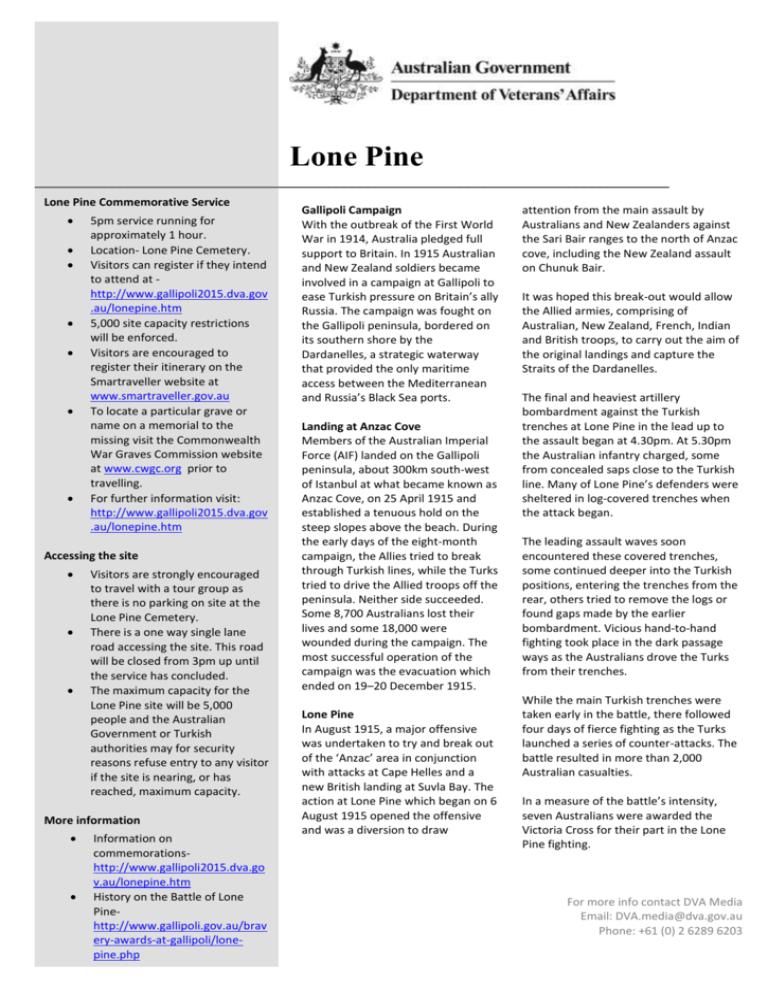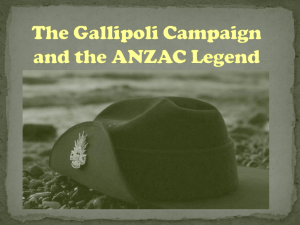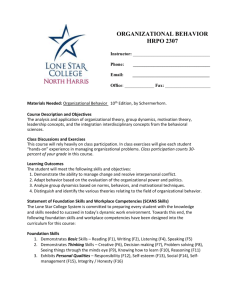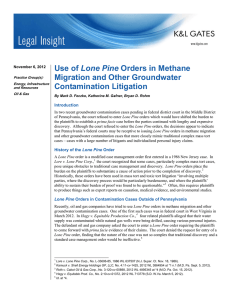Lone Pine Media Backgrounder
advertisement

Lone Pine __________________________________________________________________________________ Lone Pine Commemorative Service 5pm service running for approximately 1 hour. Location- Lone Pine Cemetery. Visitors can register if they intend to attend at http://www.gallipoli2015.dva.gov .au/lonepine.htm 5,000 site capacity restrictions will be enforced. Visitors are encouraged to register their itinerary on the Smartraveller website at www.smartraveller.gov.au To locate a particular grave or name on a memorial to the missing visit the Commonwealth War Graves Commission website at www.cwgc.org prior to travelling. For further information visit: http://www.gallipoli2015.dva.gov .au/lonepine.htm Accessing the site Visitors are strongly encouraged to travel with a tour group as there is no parking on site at the Lone Pine Cemetery. There is a one way single lane road accessing the site. This road will be closed from 3pm up until the service has concluded. The maximum capacity for the Lone Pine site will be 5,000 people and the Australian Government or Turkish authorities may for security reasons refuse entry to any visitor if the site is nearing, or has reached, maximum capacity. More information Information on commemorationshttp://www.gallipoli2015.dva.go v.au/lonepine.htm History on the Battle of Lone Pinehttp://www.gallipoli.gov.au/brav ery-awards-at-gallipoli/lonepine.php Gallipoli Campaign With the outbreak of the First World War in 1914, Australia pledged full support to Britain. In 1915 Australian and New Zealand soldiers became involved in a campaign at Gallipoli to ease Turkish pressure on Britain’s ally Russia. The campaign was fought on the Gallipoli peninsula, bordered on its southern shore by the Dardanelles, a strategic waterway that provided the only maritime access between the Mediterranean and Russia’s Black Sea ports. Landing at Anzac Cove Members of the Australian Imperial Force (AIF) landed on the Gallipoli peninsula, about 300km south-west of Istanbul at what became known as Anzac Cove, on 25 April 1915 and established a tenuous hold on the steep slopes above the beach. During the early days of the eight-month campaign, the Allies tried to break through Turkish lines, while the Turks tried to drive the Allied troops off the peninsula. Neither side succeeded. Some 8,700 Australians lost their lives and some 18,000 were wounded during the campaign. The most successful operation of the campaign was the evacuation which ended on 19–20 December 1915. Lone Pine In August 1915, a major offensive was undertaken to try and break out of the ‘Anzac’ area in conjunction with attacks at Cape Helles and a new British landing at Suvla Bay. The action at Lone Pine which began on 6 August 1915 opened the offensive and was a diversion to draw attention from the main assault by Australians and New Zealanders against the Sari Bair ranges to the north of Anzac cove, including the New Zealand assault on Chunuk Bair. It was hoped this break-out would allow the Allied armies, comprising of Australian, New Zealand, French, Indian and British troops, to carry out the aim of the original landings and capture the Straits of the Dardanelles. The final and heaviest artillery bombardment against the Turkish trenches at Lone Pine in the lead up to the assault began at 4.30pm. At 5.30pm the Australian infantry charged, some from concealed saps close to the Turkish line. Many of Lone Pine’s defenders were sheltered in log-covered trenches when the attack began. The leading assault waves soon encountered these covered trenches, some continued deeper into the Turkish positions, entering the trenches from the rear, others tried to remove the logs or found gaps made by the earlier bombardment. Vicious hand-to-hand fighting took place in the dark passage ways as the Australians drove the Turks from their trenches. While the main Turkish trenches were taken early in the battle, there followed four days of fierce fighting as the Turks launched a series of counter-attacks. The battle resulted in more than 2,000 Australian casualties. In a measure of the battle’s intensity, seven Australians were awarded the Victoria Cross for their part in the Lone Pine fighting. For more info contact DVA Media Email: DVA.media@dva.gov.au Phone: +61 (0) 2 6289 6203








